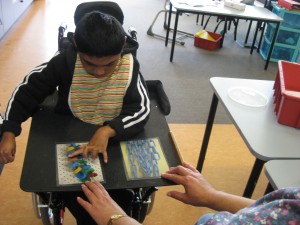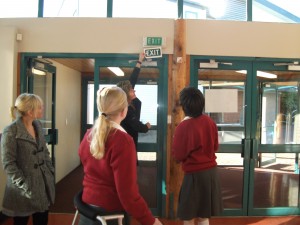
Figure 1 Kerred looks at photos
Kerred is a 7 year old boy who has a history of CVI (Cerebral Vision Impairment) and he is learning to communicate using photographs.
Kerred has spastic quadriplegia, epilepsy, and global learning delays. In figure 1 Kerred is looking at two photographs that are presented on his tray.
Salvie Naidoo classroom teacher works with Kerred at Homai Campus School where he is a student in the Kiwi Classroom.
Making choices
Kerred has recently started to make choices by selecting between two A5 photographs. The photos are presented on his tray.
Initially when asked to choose, his response was unclear. He tended to push at an object or photograph which could mean acceptance or rejection. We are working toward a more consistent way to choose and indicate his choice so that all adults working with Kerred know what he is communicating.

Figure 2 Kerred points to the one he wants
Kerred looks at each photograph. It takes a few minutes for him to decide what he wants. Kerred then lifts his hand up and moves it across his tray to point to the one he wants. He indicates his choice by touching the bottle tops. He is given the bottle tops on his tray. Kerred is very pleased with his choice and shows this by engaging with the bottle tops with a smile.
Prerequisite skills
Kerred is learning to use his vision to scan pictures. Kerred is thinking about his choices. He is able to respond to verbal prompts as well as a physical prompt at the elbow to lift his arm up to point to the photo and communicate his choice.
Possible next steps
- Encourage Kerred to consistently look at pictures before making a choice.
- Encourage Kerred to consistently touch the picture with one hand.
- Extend his choice making to a variety of contexts.
- For Kerred to work towards using the Picture Exchange Communication System (PECS) as a long term objective.
Teaching methods and strategies
- Repetition
- Consistency
- 1:1 support with physical and verbal prompting
- Daily opportunities to make choices
- Team approach particularly with the Speech Language Therapist
Learning adaptations
- Kerred responds most consistently to visual material at a distance of 30-40 cm. Photos are presented within this distance.
- Kerred needs to be well supported in his wheelchair to allow him maximum
opportunity to focus on the task.
- Images within photos should be single and well-contrasted. They should involve people and objects that are meaningful to him.
Assessment
Kerred has been communicating his likes or dislikes through body language – smiling, tensing, turning away or grizzling. Finding alternative ways of communicating that don’t rely on speech, for example, pictures or gesture.
Useful Links
More information
Email us at BLENNZ Online for more information about this subject.
We will link you up with either the author of this post or another BLENNZ colleague with whom you can continue your conversation.




